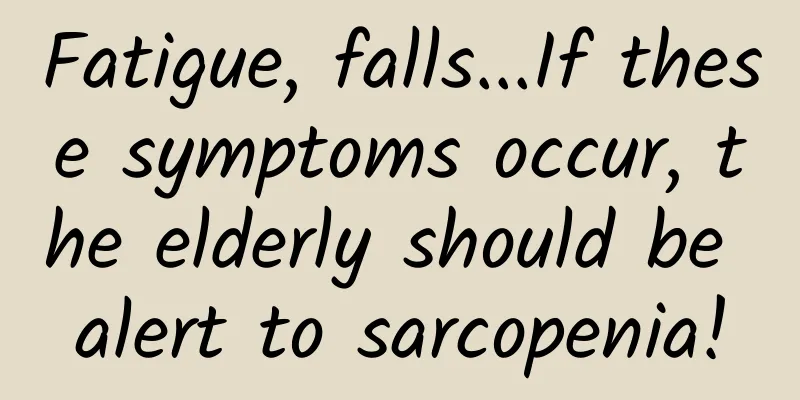Fatigue, falls...If these symptoms occur, the elderly should be alert to sarcopenia!

|
Author: Kang Lin, chief physician of Peking Union Medical College Hospital Reviewer: Li Jun, deputy chief physician, Peking University First Hospital Sarcopenia, as the name suggests, is a decrease in muscle mass, accompanied by a decrease in muscle strength. According to statistics, the body's muscle content begins to decline from around the age of 40, and after around the age of 75, it will decline by 15% every decade. This is a natural physiological process, just like gray hair and wrinkles on the face, which cannot be reversed. However, if the decline is too fast, affecting the function and limiting the activity, it should be paid attention to. 1. How can the elderly diagnose whether they have sarcopenia? There is a self-assessment questionnaire in the clinic, which can be used to judge whether there is a problem with your muscle strength based on your own performance at home: The first one is to lift a weight of about five kilograms. Do you feel it is not strenuous at all, very strenuous, or a little strenuous? Different answers correspond to different scores. This is an assessment method that reflects upper limb strength. The second is assisted walking, such as walking normally in the room without any auxiliary tools, relying on one's own strength. Is it completely without difficulty, very difficult, or only a little difficult? Different answers correspond to different scores. The third is to stand up from the sofa, chair or bed, without the help of upper limbs, without using hands to support, can you stand up by yourself? Do you find it difficult? This can be a good way to judge the problem of lower limb muscle strength. The fourth question is about climbing stairs. For example, climbing ten steps, or the distance of one floor, would you find it difficult? Would it be completely easy, very difficult, or just a little difficult? The last one is whether you have ever fallen during normal walking. If you have fallen in the past year, it is believed that you may have lost muscle mass, which has caused an adverse consequence. Figure 1 Original copyright image, no permission to reprint You can score yourself according to the sarcopenia self-assessment questionnaire above. If the total score is less than 4 points, it indicates that there is no risk of sarcopenia and you can be screened again after a while; if the total score is ≥4 points, it indicates that there is a risk of sarcopenia and it is recommended to seek medical screening in time and actively receive treatment. 2. How to treat sarcopenia? First of all, we must treat the cause of the disease. If the elderly person has some chronic wasting diseases, such as heart and lung diseases, or tumor diseases, we must treat these primary diseases first. For those who suffer from sarcopenia simply due to aging, insufficient nutritional intake, or reduced exercise, treatment should also be directed at the cause. So in general, the treatment of sarcopenia involves three aspects: nutrition, exercise, and drug treatment. Drug treatment is the last of the three treatments because some drugs, such as growth hormone, can theoretically promote muscle synthesis, including androgens, which can also increase muscle content by affecting muscle cell components, including insulin regulatory factors, and can also play a therapeutic role in sarcopenia. However, these drugs are not part of the normal process of life, aging, illness and death. Therefore, unless the elderly have very severe muscle loss, such as being on a ventilator, or have some very serious diseases that require surgery, too little muscle may affect the prognosis. At this time, some drugs may be used in the short term to increase muscle. Most elderly people in the community can maintain their muscle function well through nutrition and exercise. 3. How can elderly people with sarcopenia improve their nutrition and exercise effectively? Protein is the main raw material for muscle synthesis, so a high-protein diet can slow down the rate of muscle loss to a certain extent. In general, it is recommended to consume 1.0-1.5g/kg body weight of protein per day. It is especially recommended to choose animal protein, such as whey protein extracted from milk. 1000g of milk can extract 7g of whey protein, which can greatly reduce the food burden of the elderly. In addition, muscle and bone metabolism share common pathways, so it is recommended to supplement 800 units of vitamin D per day, which can also improve muscle content and muscle function. Figure 2 Original copyright image, no permission to reprint In terms of exercise, you need to do resistance training, such as lifting dumbbells, riding a bicycle, swimming, etc. You can also use elastic bands, sandbags, etc. to exercise muscle strength, preferably with a slight sweat, and proceed step by step. In addition, the elderly should also be careful to avoid falls and fractures in their lives, because fractures can lead to prolonged bed rest, increasing the risk of lung infection, respiratory failure, and even death. 4. How long will it take for sarcopenia patients to see results if they improve their nutrition and resistance training? From the perspective of clinical practice, many elderly people will show significant improvement in the first month of follow-up through whey protein supplementation and resistance training. Many elderly people would say that they used to be unable to carry things to the supermarket by themselves and had to have someone accompany them. Now they can carry things home by themselves and feel less dependent on others. This is their very real feeling. After one month, the upper limb grip strength, walking speed, and time to stand up from a chair will all improve. In other words, from clinical observation, improvements can be seen in one month. However, it is hoped that patients can persist for three to six months, and the effect will be more obvious. Many elderly people said that they did not know to pay attention to this issue before. They thought that this was what it was like to get old, unable to walk and without strength. However, through exercise, they found that they could recover and their confidence in life increased. Then they were able to actively exercise and eat properly according to this lifestyle to maintain their muscles at a better functional level. |
>>: Migraine pain only occurs on one side? How can I stop the pain immediately?
Recommend
Apptopia: Trump's social app was downloaded 170,000 times after it was launched in February 2022, but it is still difficult to register
Research firm Apptopia said former U.S. President...
What causes soreness on both sides of the breast?
Breast health is very important for women. In rea...
3 signs after waking up remind you that your blood lipids are excessive! Can nuts actually lower blood lipids?
Nowadays, more and more people find themselves al...
How long after the IUD is removed can I get pregnant?
Inserting an IUD is a way for women to prevent pr...
What is the normal thickness of the endometrium?
Is your uterus normal? I believe that many women ...
When to use a pelvic belt
When should a pelvic belt be used? Most people do...
What changes occur in the body when a stroke "strikes"?
Your browser does not support the video tag Strok...
Why do people still get liver cancer when their liver function is normal?
Liver function test is an essential test in routi...
Five common questions about moyamoya disease in children
At what age do children with moyamoya disease dev...
A woman dreams of a little girl
Many mothers hope to give birth to girls, because...
Are skin care products containing preservatives not good products?
Not really There are some common misconceptions a...
What is the reason for the hardening after breast augmentation?
Nowadays, many women want to make their breasts f...
What to do if the wound hurts after cesarean section
Nowadays, many women choose to have a cesarean se...
[Rare Disease] Unusual headaches - neuronal intranuclear inclusion disease
57-year-old Liu Bo (pseudonym) has had severe hea...
Don’t do these 4 “eye-damaging” behaviors anymore! If you don’t pay attention, your eyes will really be “scrapped”…
As the saying goes, eyes are windows to the soul,...









